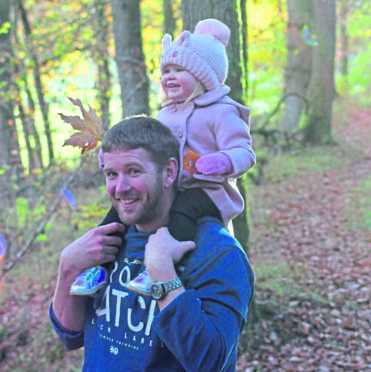NHS Grampian has ended the “postcode lottery” for patients in need of eye transplants – by agreeing to hire the equipment.
The health board does not have the right equipment to carry out the transplant, meaning patients either have to go private or try for a referral to NHS Tayside.
But when lorry driver Jason Ogg, from Inchberry near Fochabers, tried to go to Tayside he was told they did not have capacity to accept him – leaving him worried that his condition could deteriorate and risk his vision.
Mr Ogg has keratoconus, which results in the cornea becoming progressively thinner, leading to possible blurry and double vision and light sensitivity.
He needs to undergo a corneal cross linking procedure to halt the damage, but until now it has not been available from NHS Grampian due to a lack of equipment.
However, now the health board has confirmed it will hire the equipment before considering whether to routinely offer the corneal cross linking procedure.
Mr Ogg said: “My eyes are fine at the moment but if I left it unchecked then it could have got a lot worse.
“My consultant was quite happy to refer me to Dundee for the procedure. That wasn’t an issue, but I was told by them they didn’t have the capacity there to accept me. It’s been a big worry, I was probably going to have to go private until I got the news NHS Grampian was prepared to hire the equipment. It’s a big relief.”
An appointment has now been fixed for Mr Ogg to receive the treatment in January.
Moray MP Douglas Ross wrote to NHS Grampian in an attempt to speed up treatment for the Speyside resident and is pleased the health authority has acted.
He said: “The ophthalmology team at Aberdeen Royal Infirmary will assess the success of the treatment and determine if it is possible to routinely offer corneal cross linking, which would be an extremely positive move. I hope this is the first step of an improved service for local patients.”
A spokeswoman for NHS Grampian said they were assessing the feasibility of cross-corneal linking to determine whether it could be delivered in the area in the future.
She added: “We recognise it is beyond the ability of any single health board to tackle every type of rare or specialised condition on its own. That’s why we work closely with other health boards.”
A spokeswoman for NHS Grampian said they were currently assessing the feasibility of cross-corneal linking to determine whether it could be delivered in the area in the future.
She added: “We recognise that it is beyond the ability of any single health board to tackle every type of rare or specialised condition on its own.
“That’s why we work closely with other health boards across the north of Scotland to share these services by developing a variety of specialisms within each area.”
What is keratoconus?
Keratoconus affects the cornea, which is the clear window at the front of the eye, and causes it to become progressively thinner.
Eventually a cone-like bulge developes which affects the ability for people to focus properly – causing possible blurred or double vision and sensitivity to light.
About one in 450 people are affected by the condition, which is usually detected in the early stages by optometrists.
Keratoconus does not cause blindness but if left unchecked the cornea can thin to such an extent that it can make it almost impossible to focus.
Glasses or soft contact lenses can be used to correct eyesight until the advanced stages.
When those steps prove ineffective then the corneal cross-linking procedure can be used to strengthen the cornea and prevent further deterioration.
The steps involve applying a liquid vitamin to the surface of the eye, followed by treatment with a controlled application of ultraviolet light to eliminate the bulge.
The procedure has been found to be effective for most patients and involves a single 30-minute appointment.
